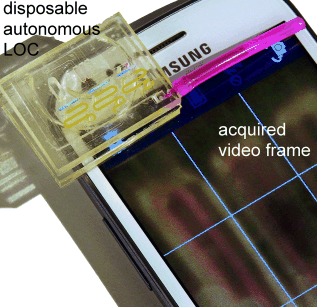Disposable lab-on-a-chip chemical assay unit with cell phone camera readout

There is growing demand for point-of-care diagnosis worldwide using low-cost, autonomous, and disposable devices. Scientists in Sweden have developed a disposable lab-on-a-chip unit that is manufactured by 3D printing technique and equipped with an integrated 3D-printed optical lens system which serves as an interface for direct readout by any regular cell phone camera. As the scientists report in the journal Angewandte Chemie, their device reliably performs quantitative chemical sensing, and the prototype is designed for colorimetric detection of the glucose concentration in a clinically relevant range.
Miniaturization of chemical sensing assay units into lab-on-a-chip (LOC) devices generally involves low reagent consumption and produces little waste, but new interfaces for integration of the LOCs into existing equipment are also required. Daniel Filippini and his group at Linköping University in Sweden have developed the unibody LOC (ULOC) 3D printing technology, which enables designing and optimizing such LOCs, especially in the view of prototyping disposables for autonomous LOC use coupled with cell phones. As a colorimetric assay, they employed a regular enzymatic glucose test, using the pink dye resorufin as the product to be detected.
With their design of their prototype ULOC glucose meter in hand, the scientists established an interface to a simple cell phone camera. Filippini explains: "We chose a design that simply sits on the phone front camera, wherever this is positioned in the phone model, and forms an image of the detection region with the aid of a 3D printed lens." In addition, user interaction was minimized to simple actuation by one low-cost finger pump integrated in the ULOC design. Another challenging aspect, however, was finding a reliable quantification scheme different from the classical intensity-based one, because the device employs ambient-light illumination, which distribution is not possible to control. Therefore, the scientists exploited the capability of the cell phone to take videos, thus measuring the time to the intensity maximum, which is also related to the concentration and is robust to illumination spatial modulations.
For operation, the ULOC was placed on the cell phone camera and the test manually started by finger pump actuation. A seven-minute video of the color changes in the detection chambers was taken and analyzed to resume the actual glucose concentration of the sample. This design can be adapted to other assays such as the detection of hydrogen peroxide in aqueous solutions and other enzymatic or non-enzymatic systems, as Filippini indicates. The ULOC prototypes cost 1.38 US$, including the printed optics. It is indeed a cunning approach to solving a universal diagnostic issue.
More information: "Autonomous Chemical Sensing Interface for Universal Cell Phone Readout." dx.doi.org/10.1002/anie.201503727
Journal information: Angewandte Chemie
Provided by Wiley




















